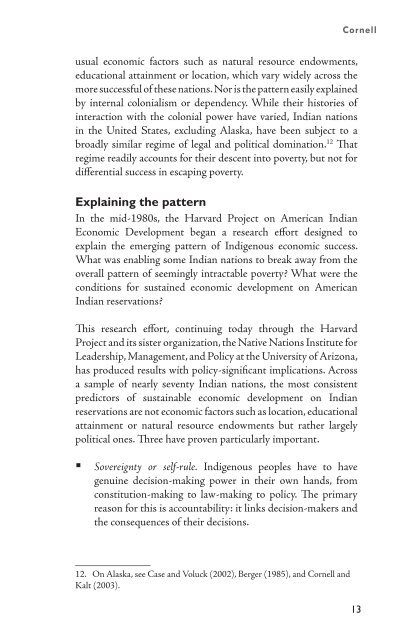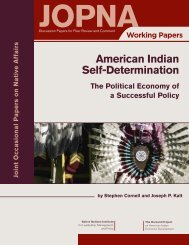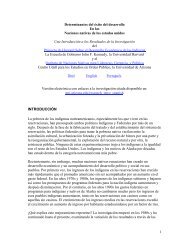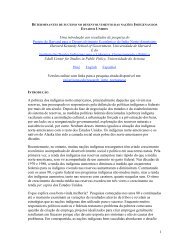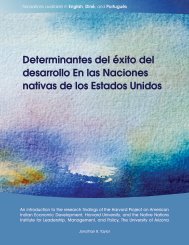Indigenous Peoples, Poverty, and Self-Determination in Australia ...
Indigenous Peoples, Poverty, and Self-Determination in Australia ...
Indigenous Peoples, Poverty, and Self-Determination in Australia ...
You also want an ePaper? Increase the reach of your titles
YUMPU automatically turns print PDFs into web optimized ePapers that Google loves.
Cornellusual economic factors such as natural resource endowments,educational atta<strong>in</strong>ment or location, which vary widely across themore successful of these nations. Nor is the pattern easily expla<strong>in</strong>edby <strong>in</strong>ternal colonialism or dependency. While their histories of<strong>in</strong>teraction with the colonial power have varied, Indian nations<strong>in</strong> the United States, exclud<strong>in</strong>g Alaska, have been subject to abroadly similar regime of legal <strong>and</strong> political dom<strong>in</strong>ation. 12 Thatregime readily accounts for their descent <strong>in</strong>to poverty, but not fordifferential success <strong>in</strong> escap<strong>in</strong>g poverty.Expla<strong>in</strong><strong>in</strong>g the patternIn the mid-1980s, the Harvard Project on American IndianEconomic Development began a research effort designed toexpla<strong>in</strong> the emerg<strong>in</strong>g pattern of <strong>Indigenous</strong> economic success.What was enabl<strong>in</strong>g some Indian nations to break away from theoverall pattern of seem<strong>in</strong>gly <strong>in</strong>tractable poverty? What were theconditions for susta<strong>in</strong>ed economic development on AmericanIndian reservations?This research effort, cont<strong>in</strong>u<strong>in</strong>g today through the HarvardProject <strong>and</strong> its sister organization, the Native Nations Institute forLeadership, Management, <strong>and</strong> Policy at the University of Arizona,has produced results with policy-significant implications. Acrossa sample of nearly seventy Indian nations, the most consistentpredictors of susta<strong>in</strong>able economic development on Indianreservations are not economic factors such as location, educationalatta<strong>in</strong>ment or natural resource endowments but rather largelypolitical ones. Three have proven particularly important.• Sovereignty or self-rule. <strong>Indigenous</strong> peoples have to havegenu<strong>in</strong>e decision-mak<strong>in</strong>g power <strong>in</strong> their own h<strong>and</strong>s, fromconstitution-mak<strong>in</strong>g to law-mak<strong>in</strong>g to policy. The primaryreason for this is accountability: it l<strong>in</strong>ks decision-makers <strong>and</strong>the consequences of their decisions.12. On Alaska, see Case <strong>and</strong> Voluck (2002), Berger (1985), <strong>and</strong> Cornell <strong>and</strong>Kalt (2003).13


